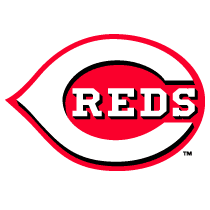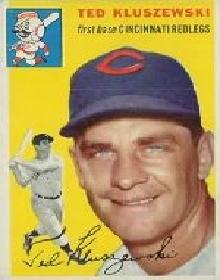






 |  |  |  |  |  |  |
 |
 |
Widely recognized for his huge biceps and big forearms, the 6-foot, 2-inch, 240-pounder Kluszewski was one of the most feared major league hitters in his prime, despite the fact that he was often injured and only had four complete seasons in a 15-year playing career. Selected an All-Star in four seasons, Kluszewski was a career .298 hitter with 279 home runs and 1028 RBI in 1718 games. There is no question he was an intimidating presence in the batter's box. In 10 of his 15 seasons he walked more often than he struck out, compiling a respectable 1.348 walk-to-strikeout ratio (492-to-365). In 1955, he hit 47 homers while striking out only 40 times. No player since him has hit 40 homers and struck out 40 or fewer times in the same season (Barry Bonds missed duplicating this feat by one strikeout in 2004).
Kluszewski enjoyed his most productive years from 1953 through 1956, with home run totals of 40, 49, 47 and 35 while collected 100-plus RBI in each of those years, including a league-leading 141 in 1954. He also hit . 300 or more eight times. A fine fielder, he led the National League first basemen in fielding percentage five straight years, a major league record.
Kluszewski spent his last four seasons switching teams. He was traded to the Pittsburgh Pirates before 1958, and in August 1959 he was sent to the Chicago White Sox, providing punch in the American League stretch. Finally, Chicago faced the Los Angeles Dodgers in the 1959 World Series. The White Sox expected to run on the Dodgers in the Series, but catcher Johnny Roseboro's arm put an end to manager Al Lopez' ideas conceived around speedy Luis Aparicio. In Game One at Comiskey Park, Kluszewski hit two home runs with five RBI to led Chicago to an 11-0 victory, but the Dodgers took four of the next five games behind a strong pitching performance which silenced the White Sox batters except for Kluszewski, who led Series hitters in home runs (3) and RBI (10), and tied with Gil Hodges in batting average (.391).
Kluszwesky was selected by the Los Angeles Angels during the 1960 expansion draft. On April 11, 1961, he belted two home runs that highlighted the first victory for the Angels in the American League. Basically used as a pinch hitter, he hit .243 with 15 home runs and 39 RBI in 107 games, retiring at the end of the season. After that, he returned to Cincinnati as a hitting coach from 1970 to 1978 on the Big Red Machine teams under manager Sparky Anderson. In 1979 he became the Reds' minor league hitting instructor, and resigned in 1986, after he suffered a heart attack that required bypass surgery.
4-time All-Star (1953-56)
3-time Top 10 MVP (7th, 1953; 2nd, 1954; 6th, 1955)
7-time Top 10 in batting average (1949-50, 1952-56)
Led league in home runs (49, 1954)
Led league in RBI (141, 1954)
5-time led first basemen in fielding percentage (1951-55), a major league record
Set a National League record scoring runs in consecutive games (17, 1955)
Kluszewski, Gus Bell and Bob Thurman became the second trio of teammates with a 3-HR game in the same season (1956), sharing a major league single season record with Duke Snider, Roy Campanella and Tommy Brown (Brooklyn Dodgers, 1950) and Cory Snyder, Joe Carter and Brook Jacoby (Cleveland Indians, 1987).
Kluszewski was inducted into the Cincinnati Reds Hall of Fame in 1962. Great American Ball Park, new home of the Cincinnati Reds, opened its doors on March 31, 2003. Before the inaugural game, the Reds dedicated a bronze statue of Kluszewski on the plaza outside the main gate. More statues were added later in the season, honoring players also from the Crosley Field era such as catcher Ernie Lombardi, pitcher Joe Nuxhall and outfielder Frank Robinson. The statues were sculpted by Cincinnati artist Thomas Tsuchiya.
Ted Kluszewski is prominently mentioned in the first line of the chorus to Terry Cashman's Willie, Mickey, and the Duke, a 1981 tribute to Major League Baseball

 |  |  |  |  |  |  |